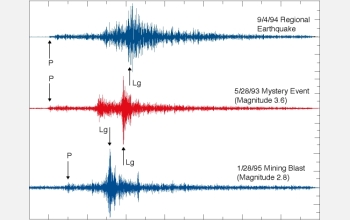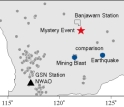News Release 97-041
Seismic Mystery Remains in Australia
Scientist-sleuths to report on latest findings
May 28, 1997
This material is available primarily for archival purposes. Telephone numbers or other contact information may be out of date; please see current contact information at media contacts.
It's a tale of Down Under, set against a backdrop of international terrorism.
On a dark night in May, 1993, somewhere in the empty miles of dry-as-dust Australian outback, a streak blazed through the sky and the ground shook, according to eyewitnesses, aborigines prospecting for gold.
In a likely script for an episode of the "X Files," the event happened near a ranch owned by the Japanese cult "Aum Shinrikyo," the group accused of the poison-gas attack on Tokyo subways in 1995. Investigators in Australia and the United States raised concerns, at first, that the seismicity might be the result of cult activities. Cult followers had recently acquired land on the outback, and were known to be mining uranium and carrying out weapons tests there.
The U.S. Senate's Permanent Subcommittee on Investigations became interested and requested that scientists affiliated with the National Science Foundation (NSF)-supported Incorporated Research Institutions for Seismology (IRIS) in Washington, D.C., look into the incident. IRIS scientists have been studying, ever since, seismic recordings of the occurrence for the subcommittee.
The sleuths have concluded from seismic data--after ruling out a nuclear detonation--that the earth's trembling on that dark May night could have been caused by the impact of a meteorite made of iron.
The scientists will present a report on their latest findings, Earthquake Sources: Processes and New Observations, at the spring meeting of the American Geophysical Union, May 28, at 1:30 p.m. at the Baltimore Convention Center.
"If the eyewitness accounts are credible," says seismologist Gregory van der Vink, director of planning at IRIS, "the seismic signal was most likely created by the impact of an iron meteorite about two meters in diameter. Such a meteorite could survive passage through the atmosphere, and impact earth with sufficient energy to create the seismic signal picked up by one of our stations in the Global Seismographic Network." But, as there is no previously known digital seismic signal from a meteorite impact, "we have nothing to compare this record to," adds Christel Hennet, van der Vink's colleague at IRIS.
The IRIS scientists--joined in their quest by researchers Danny Harvey of the University of Colorado, Chris Chyba of the University of Arizona, and Vipin Gupta of Sandia National Laboratory--estimate that only about once every ten years does an iron meteorite of this size survive its hurtling free-fall through earth's atmosphere, and reach our planet's surface intact.
"A meteorite this size would create a crater and thus provide positive evidence of what the seismic network readings indicate," says van der Vink. "But as yet, no such crater has been found."
The impact of a meteorite this large would produce a hole the size of a football field, difficult to overlook in populous regions of the world, but perhaps hard to find in the wide Australian outback, the equivalent of trying to locate a contact lens in a barn. "But we now have a good determination of the location from analyzing the seismic records, and are working with Sandia Labs to track it down," says van der Vink. "We're closing in on an answer to this mystery."
If no crater can be found, says van der Vink, then the event may have been caused by an earthquake.
If a crater is never found, and there is no credible alternative explanation for the eyewitness accounts, he says, "we may never know what happened that night in a remote corner of Australia."
-NSF-
-
Map location of the 1993 seismic mystery event in Australia.
Credit and Larger Version
Media Contacts
Cheryl L. Dybas, NSF, (703) 292-8070, email: cdybas@nsf.gov
Program Contacts
Marcia Steinberg, NSF, (703) 292-8443, email: msteinbe@nsf.gov
The U.S. National Science Foundation propels the nation forward by advancing fundamental research in all fields of science and engineering. NSF supports research and people by providing facilities, instruments and funding to support their ingenuity and sustain the U.S. as a global leader in research and innovation. With a fiscal year 2023 budget of $9.5 billion, NSF funds reach all 50 states through grants to nearly 2,000 colleges, universities and institutions. Each year, NSF receives more than 40,000 competitive proposals and makes about 11,000 new awards. Those awards include support for cooperative research with industry, Arctic and Antarctic research and operations, and U.S. participation in international scientific efforts.
Connect with us online
NSF website: nsf.gov
NSF News: nsf.gov/news
For News Media: nsf.gov/news/newsroom
Statistics: nsf.gov/statistics/
Awards database: nsf.gov/awardsearch/
Follow us on social
Twitter: twitter.com/NSF
Facebook: facebook.com/US.NSF
Instagram: instagram.com/nsfgov




